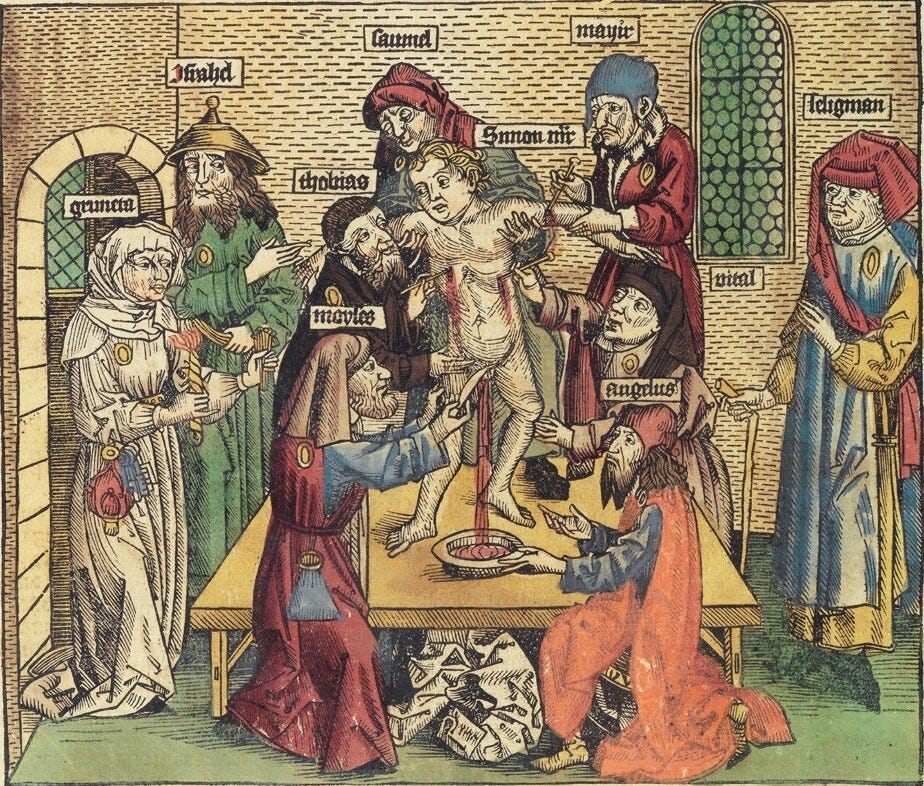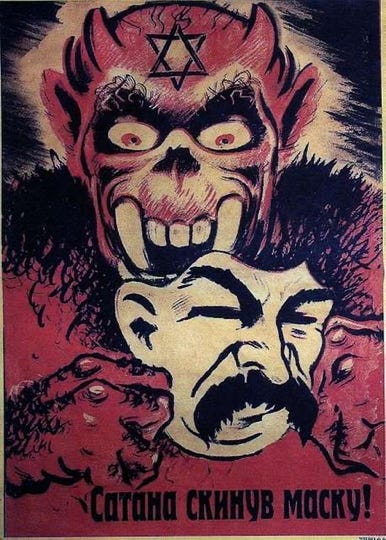The First Red Scare
A medieval conspiracy theory
When we hear the term “red scare” we think of communism. And that’s not for nothing. The color red is closely associated both with the Soviet Union, which employed the symbol of the red flag emblazoned with hammer and sickle, with “red” China, with the Italian red brigades, with the Khmer Rouge, and so on.
Over the last century-and-a-bit there have been several red scares. One, in the United States, occurred in the aftermath of the Russian revolution. Another, also in the United States, was a Cold War development. A third was at the core of Nazi ideology during the 1920’s, 30’s and 40’s. But all of these red scares had a prequel centuries earlier in the medieval conspiracy theory of the Red Jews.
This is an animal called a Manticore. From ancient times through the European Middle Ages, the manticore was believed to be a very real and very dangerous creature that lived somewhere in the East. Aristotle described it as an animal with…
“…three rows of teeth in each jaw; it is as large and as rough as a lion, and has similar feet, but its ears and face are like those of a man; its eye is grey, and its body red; it has a tail like a land scorpion, in which there is a sting; it darts forth the spines with which it is covered instead of hair, and it utters a noise resembling the united sound of a pipe and a trumpet; it is not less swift of foot than a stag, and is wild, and devours men.”
The 13th century theologian Thomas of Cantimpré portrayed the Manticore as “a truly monstrous animal” with “a face just like a human” that “most greedily desires human flesh.”
The monstrous Manticore pictured above is a Manticore with a difference. Its human head has a red beard and red hair, and the creature is wearing a reddish hat. This kind of hat, known as a Phrygian hat, was used in medieval art to signify that its wearer is a Jew. So, this particular illustration was meant to depict Jews as monstrous, predatory creatures.
The manticore is painted red because manticores were supposed to have red bodies. But why does this one have red hair and a red beard? During the high Middle Ages, having red hair or a red beard was associated with being Jewish. As Rebekka Voß describes in Sons of Saviors: The Red Jews in Yiddish Culture:
“Red hair…was almost uniformly assigned negative meaning [by Christians]….In popular physiognomy throughout medieval and early modern Europe, red hair was considered an outward sign of a demonic and duplicitous character and, therefore, redheads were deemed menacing. Congruent with the strong negative associations that red hair could provoke, red hair and beards had currency as a stereotypical trait of the Jewish Other from England to Spain and France to Russia.”
Why red hair and beards? It is unlikely that Jews of this period were mostly redheads. The answer is found in medieval color symbolism. Red was the color of violence, sin, and infamy. Small wonder, then, that it was so closely associated with Jews.
The Jewish manticore’s hunger for human flesh comported with the Christian belief that Jews cannibalized Christian children that emerged during the 13th century and soon morphed into the infamous blood libel.

The purported redness of Jews was also linked to the belief that far away in the east, beyond the Caucasus mountains, there lived a vile and fearsome group called the Red Jews. Segregated from the rest of Europe by the impassible Sambatyon River, or confined behind a massive wall, Christians supposed that the Red Jews would be the invading army of the Antichrist at the time of the apocalypse.
Voß explains that….
Christians saw the Red Jews’ physical coloration as a telltale sign of their bloodthirst. German vernacular texts of the Red Jews spurred fear of this barbaric horde, not only for their future service as the Antichrist’s shock troops, but for their potential to inflict harm in the present….Through this red-tinted lens the Red Jews’ sinister attributes appeared timeless, immutable from the past, present, and future. They were seen as a constant threat, not only at the dawn of an apocalyptic future, as demonstrated by the assertion that the Red Jews were culpable for the Black Death (1347-51)….which claimed the lives of an estimated one third of the European population….A yearbook from Zurich specifically ascribes the plague to the Red Jews, contending that the wells and streams were infected with poison that European Jews produced from snake venom supplied by the Red Jews.
Their skill developing biological weapons…
…was inevitably correlated with their alleged expertise in magic. Their number was said to include brilliant sorcerers, “skilled in unknown fireworks, who can make fires burn in the sky as though the fire came from heaven”….The myth of the Red Jews reflects Christian fears that Jews could unleash their attack at any time.
They were also depicted as extremely formidable, nightmarish warriors, described as “huge and horrible” and “hateful hell-hounds” striking terror into the hearts of the Christian majority.
What is the relationship between this original red scare and more recent ones?
The first red scare in the United States occurred in the aftermath of WWI and the Russian revolution in response to an upsurge of anarchist and communist activism. Fueled by a resurgent labor movement and anarchist bombing plots, and resurgent nativist sentiments, the fear of an impending communist revolution on American soil led the United States Government to take around ten thousand suspected communists and anarchists into custody and deport around six hundred of them to Russia on a ship dubbed the Red Ark in the 1919-20 Palmer raids. The second red scare in the United States occurred in the context of the cold war. It was spearheaded by prominent figures such as J. Edgar Hoover, who had been instrumental in the earlier Palmer raids, Senator Joseph McCarthy, and the House Un-American Activities Committee.
Neither of these red scares specifically targeted American Jews, although given that Jewish people were overrepresented in leftist groups, Jews were disproportionately affected (Emma Goldman, Alexander Berkman were among those deported in consequence of the Palmer raids).
Neither of these red scares had any direct link to the medieval one, even though they were both infused with the knee-jerk anti-Semitism of the day, and both involved the idea of a powerful and insidious Eastern other plotting to overthrow the United States in an apocalyptic battle between Good and Evil. It’s not difficult to discern centuries-old tropes here, originally crafted in relation to Jews and Muslims, tailored to fit novel geopolitical circumstances. But it is implausible to suppose that there is a direct lineage—a red thread—from the medieval Red Jew myth to its more recent American counterparts.
The German red scare of the mid-twentieth century is another matter. Recall that Rebekka Voß points out that the Red Jew myth was confined to the German-speaking world, and there is ample evidence that many of the anti-Semitic themes that were consolidated during the high middle ages explicitly fueled Nazi ideology (I describe this in some detail in Chapter 10 of my book Making Monsters: The Uncanny Power of Dehumanization)
The Nazi Weltanschauung merged political and racial categories. National Socialists regarded their main racial enemy—the Jews—and their main political enemies—the communists—as essentially one and the same. Seen through a Nazi lens, then, communists were red Jews. They might be actual Jews or, more fuzzily, they might be seen as exemplifications of the sinister and corrosive Jewish spirit.
The first purpose-built concentration camp, Dachau, was built to crack down on leftists, not Jews. But the bifurcation of communist and jew is misleading. As Holocaust scholar Saul Friedländer notes, during the early years of Hitler’s political ascendency “political Bolshevism, although always recognized as one of the instruments used by Jews to achieve world domination, is not one of Hitler’s central obsessions: It is a major theme only insofar as the Jews from whom it derives are the major theme.” From this perspective even Stalin was really a Jew—a Red Jew.
Like medieval German Christians, Nazis saw the clash of civilizations, the eternal conflict between Aryan and Jews, as a decisive struggle between the forces of good and the forces of evil, and despite the abortive nonaggression pact between Hitler and Stalin, they regarded it as an existential necessity to conquer the Eastern land of the Judeo-Bolsheviks and dispose of their subhuman population.
History rarely if ever repeats itself, but as Mark Twain insightfully wrote, “the kaleidoscopic combinations of the pictured present often seem to be constructed out of the broken fragments of antique legends.” The red scares of the 20th century, and in particular the Nazi red scare, provide a great illustration of Twain’s claim in their resonance with the medieval conspiracy theory of the direful Red Jews.








